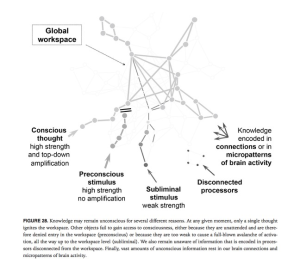Consciousness and the Brain
Consciousness and the Brain by Stanislas Dehaene
Lots of interesting stuff here — what I found most intriguing were his descriptions of tests involving borderline cases in which the subject switches from paying conscious attention to one thing to paying conscious attention to another thing. In brain imaging studies, this shows as a sharp, clear transition between states.
I didn’t find it surprising that change of focus appeared as a phase transition, reflecting our introspective awareness of the event at the neuronal level, — the reentrant neurons that form the necessary positive feedback loops have been described at least as far back as Edelman in the early 1990’s.What was surprising (although like so many things, “obvious in retrospect”), is that in cases in which there is a rivalry between multiple, conflicting interpretations, the complete active conflict set remains humming along in the brain at the level below conscious selection, even to the point of maintaining a semantic analysis on the components. Dehaene backs this up with a lot of experimental data (which I found convincing). It also fits well with our introspective analysis of our task switching speed. Again in retrospect, the speed at which were are able to switch tasks precludes readdressing the semantic meaning of our thoughts every time we shift the focus of our conscious attention. (Although one could argue that it’s surprising that our actual context switch speed matches our introspective impression — subjective time impressions aren’t the most accurate clocks on the planet).
Dehaene’s experimental study of consciousness is focused on what happens when the test subject begins to pay conscious attention to an item. As just described, conscious attention is an event that is characterized by easily monitored changes in neural activity and has proven to be very highly correlated with the test subjects’ reports of paying conscious attention. As such, it is amenable to study with current scientific methods. We’re not talking qualia here, e.g, what does it feel like to see red, rather we’re talking about what happens in the brain when the subject claims to become conscious of something. These are discrete step function events. They don’t require fine grained mapping from one brain endowed entity to another (aka shared subjective experience).
Dehaene’s data shows that preconscious/unconscious processes actively tee up items available for conscious attention. In so doing, he introduces an extremely useful distinction between conscious, preconscious, and subliminal thought processes.
These studies examine the liminal border of consciousness. They don’t address the lower level details of neural processing. Dehaene shows that extensive preconscious processing is required to allow these items to be “hot swapped” into the attentive conscious processing parts of our brain with very short transition times — a task switching operation conceptualized as common to computation and psychology
Dehaene gravitates towards a global workspace theory of consciousness that permits global coordination of the various brain modules (vision, hearing etc.), providing not just a global workspace, but also global synchronization and demarcation of the importance of the thing that is the current subject of the conscious thought.
If workspace theory is right, consciousness may have evolved to mitigate this modularity. Thanks to the global neuronal workspace, information can be shared freely across the modular processors of our brain. This global availability of information is precisely what we subjectively experience as a conscious state.
Another interesting knock-on effect is that for particular types of decisions, non-conscious processing is often superior to conscious processing
The participants read the problem, then half of them were allowed to consciously think about what their choice would be for four minutes; the other half were distracted for the same amount of time (by solving anagrams). Finally, both groups made their choice. Surprisingly, the distracted group picked the best car much more often than the conscious-deliberation group (60 percent versus 22 percent, a remarkably large effect given that choosing at random would result in 25 percent success). The work was replicated in several real-life situations, such as shopping at IKEA: several weeks after a trip there, shoppers who reported putting a lot of conscious effort into their decision were less satisfied with their purchases than the buyers who chose impulsively, without much conscious reflection.
Dehaene goes on to postulate some mechanisms for this, highlighting the fact that it isn’t unlikely that biological neural networks would be good at multiplying factor values X weights and adding up the results. These multiply/add are well within the capabilities of networks of neurons and historically were one of the reasons the multiply/add architecture of “neural network algorithms” were felt to exhibit neuron like behavior.
This background processing of factors being considered, and weighting their importance to form a decision, fits very well with the common cultural memes of “sleep on it,” “think about something else and comeback fresh” etc. Given that we can only consciously process a few items at a time (~5 +- 2, is a number commonly used) it makes some sense that a global broadcast (scattering) of a few things out to our various brain modules for further consideration, followed by a gathering of the results would be very effective: basically a breadth first parallel each — given the highly parallel nature of the brain, a good way to go.
There’s two overarching messages I take away from reading this book:
The first message is that mechanisms are clearly in place to enable a lot of processing at the unconscious level. As is claimed in the book, consciousness is going to be necessary for global communication and goal setting (new tasks, new approaches — piloting the ship as it were), but much of the rest of our lives doesn’t require conscious activity, per se.
The second message is around brain injury, and other forms of brain degradation: Given the breadth of, and necessity for, such complex non-conscious activities raises the question: is it possible that impairments that we think of as impairments of consciousness, are actually impairments in some of these necessary preconditions which occur via preconscious/subliminal processes? For example problems with visual processing in people with Alzheimer’s are well known, and we’ve certainly only just begun to scratch the surface.
This isn’t something that’s thoroughly addressed in this book, but something I hope to investigate more in the future. Other than the use of patients with existing brain injuries as experimental subjects, Dehaene investigation of trauma is focused on persistent vegetative states — an orthogonal concept.


Leave a Reply to The Consciousness Stack | deictic.netCancel reply